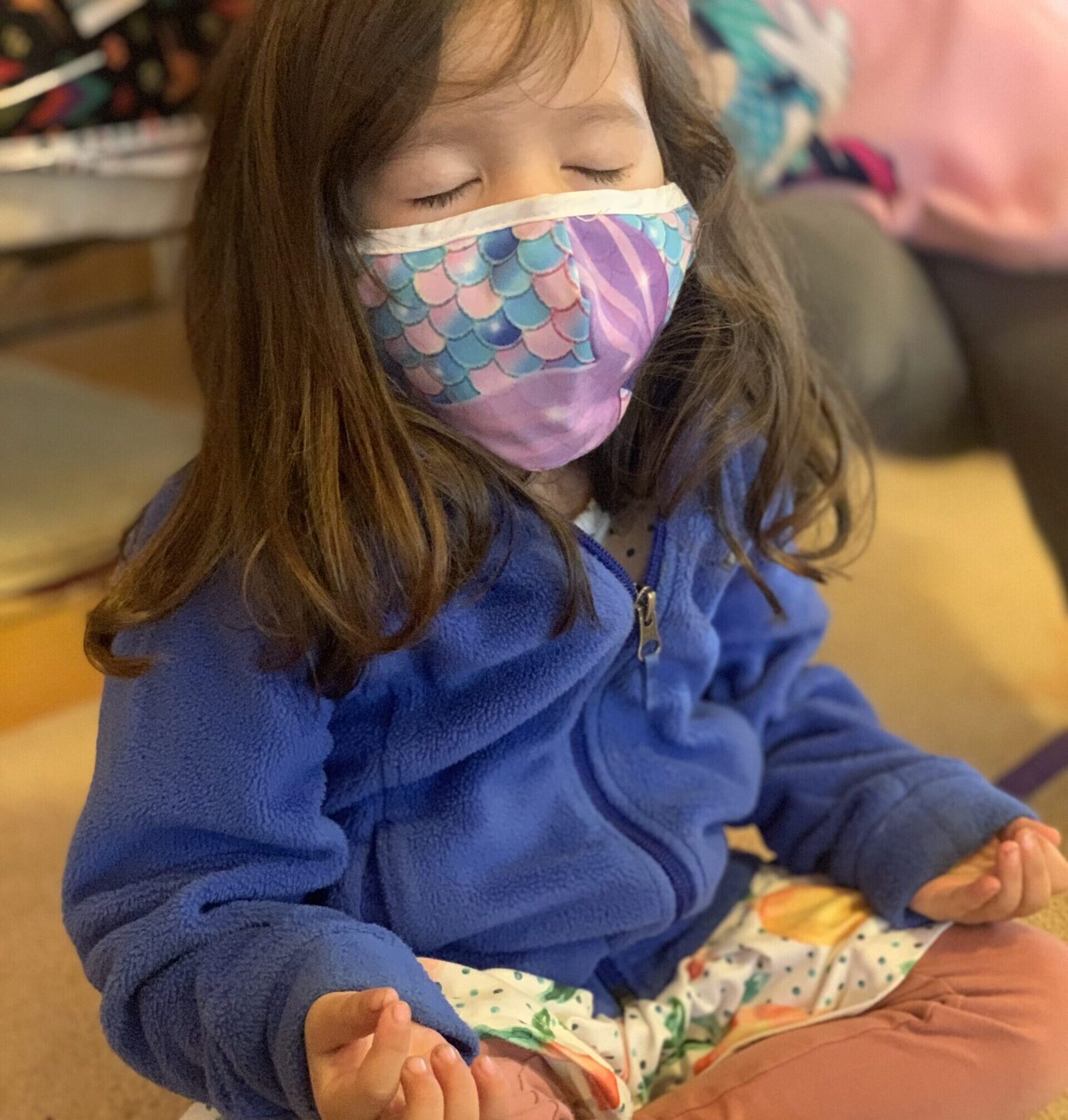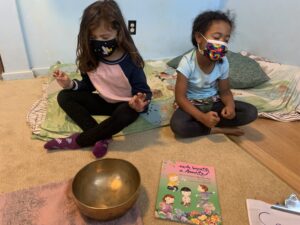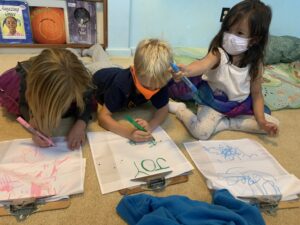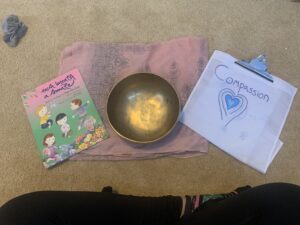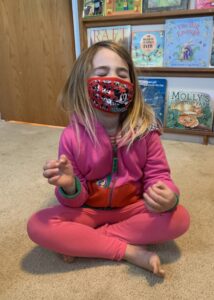 It is my conviction that there is no way to peace — peace is the way. — Thich Nhat Hanh
It is my conviction that there is no way to peace — peace is the way. — Thich Nhat Hanh
Children are naturally more present than grown-ups. They are honest, in the moment, yet often are a bit “wound up.” Practicing mindfulness with young children helps them drop into a state of calm and focus allowing them to be more receptive and therefore learn better. As children grow, and school demands more of their attention and focus, mindfulness enables them to learn more by increasing their attention span. Furthermore, teaching these practices at a young age helps children develop their skills for nurturing an internal sense of calm, as well as cultivating the ability to pause before reacting; and thus, contribute to vital social-emotional learning. These are crucial relational skills for both these interpersonal and intrapersonal connections and ultimately building the foundation for peace.
In the Mount Madonna School (MMS) preschool program, we teachers are developing our mindfulness within the classroom and out in the world. Our young students take to these practices in such beautiful ways. One of our first big lessons was an ongoing practice over the course of a week, in which small groups were invited to our small, cozy library room. We read a very important book by Sister Susan based on the teachings of Thich Nhat Hanh called “Each Breath a Smile.” Following the story, we did a short meditation practice to work on setting intention and planting seeds in our hearts for what we want to bring into our school community and lives. Each child then shared their word of intention and I helped them write the word on a prayer flag and they drew a picture about it. These flags now surround our outdoor garden, reminding us of our peaceful meditation and the intentions we set.
 Students also participate in a game I call Silence Stamina. This is simply played by sitting still and trying not to make sounds and timing it. We try to break our own record, though at the beginning it may be as brief as 13 seconds and now we have observed a minute and half as a record! I have had first and second graders make a record of 22 minutes! Some children really love this challenge, while others love to interrupt it!
Students also participate in a game I call Silence Stamina. This is simply played by sitting still and trying not to make sounds and timing it. We try to break our own record, though at the beginning it may be as brief as 13 seconds and now we have observed a minute and half as a record! I have had first and second graders make a record of 22 minutes! Some children really love this challenge, while others love to interrupt it!
In the yogic traditions of Mount Madonna Center, MMS preschool students did a practice with their fourth grade buddies, of yoga asana (movement and yogic postures), pranayama (breathing exercises) and mantra (chanting) in a redwood glade on our school campus, known as the Fairy Forest. It was a beautiful practice ending with a Silence Stamina, and while we only were silent for a short time, the children were notably calmer, more grounded and the overall energy was less frantic following our practice.
 One of the most gratifying aspects of sharing these practices with young children is when they begin to practice them voluntarily. Recently, during a birthday circle celebration, as many of the children were quite excited, I looked over to note that one of our students began a meditation sitting cross-legged with a mudra (hand yoga). Within a few minutes two other children had joined her. On one side of the circle, the three children sat quietly for a few moments until they felt calm and focused and were able to join the festivities with deeper presence. It is in these moments I feel I have done my job, when I witness the children practice mindfulness in their own lives, as they recognize a need for greater calm and focus.
One of the most gratifying aspects of sharing these practices with young children is when they begin to practice them voluntarily. Recently, during a birthday circle celebration, as many of the children were quite excited, I looked over to note that one of our students began a meditation sitting cross-legged with a mudra (hand yoga). Within a few minutes two other children had joined her. On one side of the circle, the three children sat quietly for a few moments until they felt calm and focused and were able to join the festivities with deeper presence. It is in these moments I feel I have done my job, when I witness the children practice mindfulness in their own lives, as they recognize a need for greater calm and focus.
MMS preschool students are learning that these moments of presence and calm can help them be more emotionally literate and create strong bonds with friends. Students learn to communicate mindfully through their ability to pause and touch into their own emotions. This is our first guidepost for mindful communication. MMS preschool teachers often ask students to “check in with your body”’ and see if they are cold, hot, hungry or have to use the bathroom. Then, at times we ask them to “check in with your heart.” We teach them the Anahata mudra, among others, in which they hold their palms against their hearts and close their eyes and connect to their emotional state. Students can then say out loud their feeling in a word if they choose to share it with the class group.
 These are special moments of connectedness that allow students to be present with their emotional states and share them with the group regardless of if they are pleasant or difficult emotions. This vulnerability often allows children to relate to each other when they share about missing parents, feeling excited, or other universal feelings they may want to share with others and helps to normalize these feelings and experiences. The children are able to identify and express their feelings as they navigate difficult situations such as asking for space or letting friends know how they feel.
These are special moments of connectedness that allow students to be present with their emotional states and share them with the group regardless of if they are pleasant or difficult emotions. This vulnerability often allows children to relate to each other when they share about missing parents, feeling excited, or other universal feelings they may want to share with others and helps to normalize these feelings and experiences. The children are able to identify and express their feelings as they navigate difficult situations such as asking for space or letting friends know how they feel.
As we progress throughout the year’s curriculum, we will continue to expand on our awareness practices, and we will dive into more books such as “Peaceful Piggy Meditation” by Kerry Lee Maclean and “Listening Walk” by Paul Showers. We will focus on mindfulness on our walks in the forest as well. We continue to use breathing techniques such as the traditional MMS ocean breath, and tools like chants and visualizations. Based on the Creating Compassionate Cultures curriculum, we have a “peace corner” in our classroom framed by a lovely, soft drape, for children to be in a quiet space if they need to calm during our school day. Each of these practices and tools are part of the essential building blocks for the children to establish their sense of mindfulness and peace. When they feel more peaceful within, they can feel a more peaceful connection to their friends, families, teachers, and to the world. We, as teachers, hope to guide children in mindfulness as they cultivate peace within and without.
Dedicated to Thich Nhat Hanh, whose teachings are an inspiration for peace education for children and adults worldwide.
###
Jasmine Horan is a lifelong learner and a teacher of various age groups for much of her life. She loves the wonder of childhood and the playfulness and truthfulness children bring to the world. Author of “The Gazebo Learning Project,” Jasmine specializes in early childhood education and the development of a child as a whole being.
###
Contact: Leigh Ann Clifton, director of marketing & communications,
Nestled among the redwoods on 375 acres, Mount Madonna School (MMS) is a community of learners dedicated to creative, intellectual, and ethical growth. MMS supports its students in becoming caring, self-aware, discerning and articulate individuals; and believe a fulfilling life includes personal accomplishments, meaningful relationships and service to society. The CAIS and WASC accredited program emphasizes academic excellence, creative self-expression and positive character development. Located on Summit Road between Gilroy and Watsonville. Founded in 1979.

